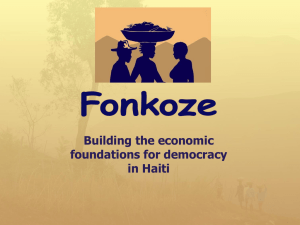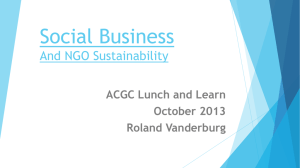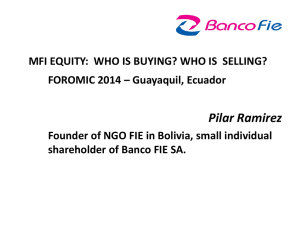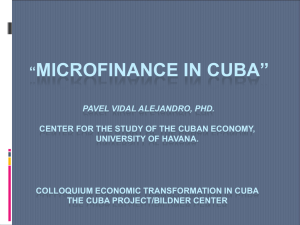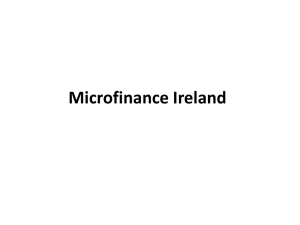PROFITABILITY & SUSTAINABILITY
advertisement
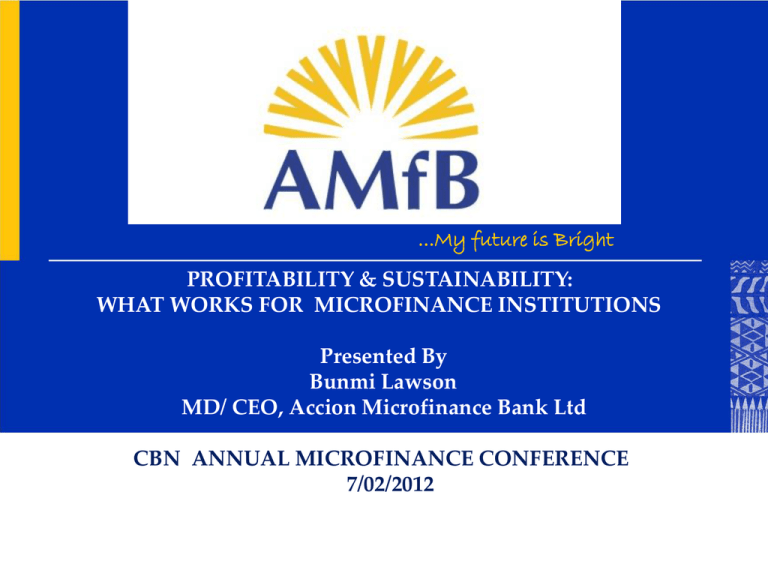
...My future is Bright PROFITABILITY & SUSTAINABILITY: WHAT WORKS FOR MICROFINANCE INSTITUTIONS Presented By Bunmi Lawson MD/ CEO, Accion Microfinance Bank Ltd CBN ANNUAL MICROFINANCE CONFERENCE 7/02/2012 Why Do Microfinance Institutions Exist? • To provide a panacea to poverty • To provide access to funding to the poor for income generating purposes • To provide a range of financial services to the poor • To bank the unbankable and underserved • To make a profit 2 Triple Bottom Line (TBL) • TBL argues that companies should be preparing three different (and quite separate) bottom lines. One is the traditional measure of corporate profit—the “bottom line” of the profit and loss account. • The second is the bottom line of a company’s “people account”—a measure in some shape or form of how socially responsible an organisation has been throughout its operations. • The third is the bottom line of the company’s “planet” account—a measure of how environmentally responsible it has been. 3 Triple Bottom Line (contd.) • A triple bottom line enterprise seeks to benefit many constituencies, not exploit or endanger any group of them. • In some ways, the TBL is like the balanced scorecard as it operates on the same principle of :what you measure is what you get, because what you measure is what you are likely to pay attention to. 4 Triple Bottom Line Environment Social Profit 5 Well defined mission For example in this mission statement - “ To economically empower micro-entrepreneurs and low income earners by providing financial services in a sustainable, ethical and profitable manner” 6 Bottom Line 1 – Profit • Some people infer that Microfinance should be non profit as profit making is seen as profiting from the poor • There is the worry that an excessive concern for profit in microfinance will lead MFIs away from poor clients to serve better-off clients who want larger loans • Profit focused microfinance may lead to over-indebtedness of poor clients • M. Yunus rightly says that the lure of profits has, in some cases, attracted players with questionable motivations and with practices that must be condemned. 7 The benefit of making profit • Attracts Capital • Attracts better and more qualified Board for good Governance • Attracts better qualified and competent/ committed staff • Generates additional resources • Enables the MfB Reach more people in its social mission • Empower more people 8 Non- Profit • Not sustainable short term life • Can only make small size loans • Usually small without reaching scale • Threat of insolvency if donation flow is cut off • Poor customer service • Low innovation • Less transparent than For- Profit • Poor use of technology • Profit is good for the Microfinance Institution 9 How profitable should Microfinance Banks be? • How Profitable? – A balance must be struck between making a profit and social issues that are pertinent to the existence of the customer/ business • What is acceptable in the Environment/ Market of operation? 10 How profitable should Microfinance Banks be? • What are the costs of operations? Are they efficient? – Microfinance is a high cost business. As a business model, its greatest challenge is to lower the operating costs in order to reduce the cost of service borne by borrowers. – Since operating expenses are the main component of interest rates, identifying their drivers and quantifying them constitute the first steps in finding ways to improve efficiency of microfinance institutions worldwide. – The fixed cost of processing loans of any size, the assessment of potential borrowers, their repayment prospects, administration of outstanding loans, collecting from delinquent borrowers, all affect the costs of operations 11 How profitable should Microfinance Banks be? • What are the funding costs? – How expensive is it to get funding? – Cost of funding may be related to interest rates charged – Source for cheaper funds/ grants, etc • Subsidized loans • Non – Interest loans • Increase in savings deposit • “As MFIs, we have always stated that the growth of the base (of customers) will be critical to the reduction of costs. In addition, we can reduce costs if cheaper source of funds are made available to us,” Vijay Mahajan (President, Microfinance Institutions Network). 12 How profitable should Microfinance Banks be? • ROI benchmarks with competitors in the same market • What ROI attracts additional investments? • Beware of Mission Drift – Pressure to expand outreach can pose a dilemma to MFIs. The concern is that efforts to reach a significant scale by securing financial sustainability may lead to a tendency to provide larger loans to less poor clients and to employ stricter loan screening procedures. In other words, scale-up could lead to a drift from an MFI’s poverty alleviation mission. 13 Generating profit in a Microfinance Bank • Income – Appropriate pricing policy • How many competitors and similar products are in the market and in what price structure? • A complete understanding of production costs, profit objectives, customers, competition, and other market information helps you determine the pricing strategy that best fits your product and company. • What Interest rates to charge? Flat, declining, mixture of both. • What fees to charge? Administrative/ transaction, Service fees, etc • With this information, you know the minimum interest rate you can charge to break even and the maximum interest rate you can charge based on an estimate of customer demand. • Competition and profit objectives factor in to determine the interest rate chargeable 14 DETERMINANTS OF PRICE? Price Ceiling (“What will the market bear?”) ? ? ? Final Price (How does the company position its product/service? Acceptable Price Range ? ? ? ? ? ? ? ? Price Floor (“What are the company's costs?”) 15 ? Generating profit in a Microfinance Bank • Income contd. – Pricing Strategies • To determine the interest rates to be charged, the MFI will need to factor in the effects of competition and profit objectives. This is difficult due to the subjectivity and estimates involved. To ease subjectivity, most companies subscribe to one of five main pricing strategies: • Premium pricing • Value pricing • Cost/plus pricing • Competitive pricing • Penetration pricing 16 Generating profit in a Microfinance Bank Strategy Substitutes Entry barriers Price sensitivity Economies of scale Goal Premium None Very high None None High per unit margin Value Few High Low Low Profit Cost/plus Some Medium Medium Medium Market share and profit Competitive Many Low High High Protect market share Penetration Many Low High High Market growth and leadership 17 Generating profit in a Microfinance Bank • Income contd. – What do customers need? (Adequate product development) • What value and benefits do customers perceive in the product and how willing are they to pay for it? • What can customers affect? • Increasing competition in the microfinance sector, means that customers can switch to other providers if their needs are not being met. • Our approach should be towards researching and responding to customer needs with a strong, well-defined corporate brand, which is key to reaching and retaining more target clients. 18 Generating profit in a Microfinance Bank • Income contd. – What resources do we have? • Good Governance – Qualified & Experienced Board – generates investor goodwill and – governance plays a critical role in the performance of MFIs . The independence of the board and a clear separation of the positions of a CEO and board chairperson have are crucial to the success of the organisation. 19 Generating profit in a Microfinance Bank • Income contd. – What resources do we have? – Human Resource • After recruitment, the training & capacity building figure out as a predominant factor in preventing turnover in an MFI. • HRD should align with Business Strategy - The Human Resource person must be involved at the strategic level of decision making. • Churchill (1997) report on Managing growth: The Organizational Architecture of Microfinance Institutions signifies that the foundation of any MFI lies at the locus of interaction between the institution and its customers. The role of front line staff assumes critical importance. 20 Generating profit in a Microfinance Bank • What resources do we have? Human Resources contd. – Train staff on core ideology, mission and vision – Mentorship/ On the job training – Continuous professional development – Senior Managers development – MFIs that have the capacity—including a proven lending methodology, a well-managed staff learning program, an effective information system, access to large volume of loan capital, and the administrative capacity to process volumes of applications efficiently; are probably ready to achieve economies of scale in operation. 21 Generating profit in a Microfinance Bank • Income contd. – What resources do we have? – Scale/ Outreach Minimum number of Clients needed to be profitable Customers willing to pay N100/ transaction Cost of business = N1,000,000 You must have at least 100,000 clients to be profitable – Mass Market Strategy • Breakeven point 22 Generating profit in a Microfinance Bank • Reducing Cost • Scale – reduce cost per borrower – Reduce dependence on donor funds • Design determines cost – design the product with cost reduction in mind • Standardize processes • Retention of customers reduces cost – Lower cost of customer acquisition – Reduced use of resources based on good repayment / behavior 23 Generating profit in a Microfinance Bank • Reducing Cost – Reduce overheads • Procurement Costs • Better customer service leads to more sales • Retention reduces cost 24 Generating profit in a Microfinance Bank • Cost - Reducing Cost – Streamline processes • Efficiency • Using and improving on technology available • Balance control Vs service efficiency 25 Generating profit in a Microfinance Bank • Reducing Cost – Invest in new and relevant technology • Technology driven Vs manual – POS – ATM – Mobile Banking • Core banking software • Automate key processes: accounting, HR etc • Risk Management 26 Social assessment score card Objective of most Microfinance Banks is to address poverty and help increase income . S = Social Mission AMfB has developed its Social and Environmental Assessment Score Card O= Outreach C = Client Service I = Information, Transparency & Consumer protection A = Association with the Community L = Labour 27 Social Mission Performance Indicators 1. Define Social Mission 2. Evidence of Commitment to Mission – Staff: Board: Strategic Plan 3. Evaluation of Mission Fulfillment - What should be evaluated/monitored 4. Client Outreach – % Category of Client – % Income to GDP – Average Loan Size – Increase in income over 5 years 28 Outreach Performance Indicators 1. Geographical Coverage – Local Government and Growth in Numbers. 2. Depth of Reach – % Female – % Male – % Education Level – % Without Prior Banking 3. Products and Services – Simple, Easy & Friendly 29 Client Service Performance Indicators 1. Client Retention 2. Benefit to Long Standing Customers 30 Information Transparency & Consumer Protection Performance Indicators 1. Transparency – Disclosure of loan terms to clients 2. Disclosure of Accounts on the Mix 3. Website 4. Consumer Protection 5. Code of Conduct for Board & Employees SMART Campaign- aligning behind six key principles of consumer protection 31 Association with the Community Performance Indicators 1. Defined Corporate Social Responsibility Project – Positive impact on clients – Benefit to Immediate Community – Benefit to larger community 2. Leadership role in NAMB 32 Association with the Community contd. 3. Environmental impact • Exclusion List – Firearms – Alcoholic beverages – Tobacco – Gambling, Casinos – Radioactive Materials – Harmful Child labour 33 Labour Climate Performance Indicators 1. Staff Retention % 2. Training Cost as a % of Salary 3. Compensation Bench Mark 4.Staff Feed Back mechanism 34 Key pitfalls for Microfinance Banks • Weak Board/ Governance – Balance of Control • Weak Management – Poor Salary Scales – Poor recruitment practices • Lending Methodology – Less than N250,000 loan to low income should be at least 80% • Weak Risk Management Methodology 35 Key pitfalls for Microfinance Banks contd. • PAR Delinquency Management – Strict compliance to repayment terms – – from one day, charge penalties – Reward good clients • Weak Technology – Invest in Technology over cars, buildings, etc • Weak Branding Methodology – Awareness – Communication Gaps and Inadequate Awareness 36 Profitability and sustainability of MFB 2009: MIX 37 • Falling returns especially from East and Southern Africa. Drop in revenues • Steady rise in PAR which has raised red flags amongst institutions. • Operating Expenses remain the highest in the world. (19%) • Financial expense are amongst the lowest globally, due to strong deposit base. • Low Levels of Financial intermediation correlate with poor performance • Social mission still remains a challenge. (i.e. Poverty alleviation, Women empowerment , Endorsing the Client Protection Principles-CPPs and incentives/benefits) • Social Performance integrated into the Strategic Planning process Profitability What are the two key profitability ratios? Return on Assets (ROA) Return on Equity (ROE) Operating Operating 38 Profitability: Return on Assets (ROA) Measures the capacity of the MFI’s assets to generate profits Indicator: Net Operating Income Average Assets 39 Profitability: Return on Assets (ROA) Industry Averages All FSS MBB 0.6% 2.6% ACCION 5.1% 4.94% ACCION CAMEL Africa LA (1.1%) 1.7% 0.6% 5.9% > 3.0% AMfB 40 Asia Banks NGOs 0.2% 0.8% 0.8% N/A 6.1% 1.8% Profitability: Return on Equity (ROE) Measures MFI’s ability to increase equity base via earnings from operations Indicator: Net Operating Income Average Equity 41 Profitability: Return on Equity (ROE) Industry Averages MBB ACCION Partners All FSS / OSS Africa LA Asia Banks NGOs 3.2% 11.9% (3.2%) 7.2% 2.3% 5.8% 2.4% 20.2% 22.6% (0.3%) 22.8% N/A 24.6% 6.3% ACCION CAMEL > 15.0% AMfB 42 Profitability: Operating Self-Sufficiency Averages Op Rev / (Fin + Op Expenses) Reg. NGOs LA Africa All Partners 105% 119% 116% 110% 115% ACCION CAMEL Recommended Range MFIs Operating Revenue/(Financial + Operating Expenses) AMfB 43 > 100% Profitability: Operating Self-Sufficiency Industry Averages Op Rev / (Fin + Op Expenses) All FSS Africa LA Asia Banks NGOs 124% 137% 117% 123% 123% 132% 132% 115% >120% 110% 116% 105% 119% ACCION Network Op Rev / (Fin + Op Expenses) AMfB 44 Efficiency & Productivity Operating Efficiency: • How much is being spent to maintain the outstanding portfolio? • The efficiency of an MFI can be controlled: how much is being spent on what? • Important variables include: Staffing, administrative expenses, client base Productivity: • Personnel expense is usually the largest operating expense. Larger caseload = greater efficiency! 45 Operating Efficiency Definition: Measures the MFI’s efficiency level Indicators: Operating Expenses Average Portfolio or Operating Expenses Average Assets 46 Profitability: Operating Efficiency Industry Averages All FSS Africa LA Asia Banks NGOs MBB 19.2% 16.3% 31.7% 19.5% 16.0% 16.4% 23.5% ACCION Network 27.6% 23.7% 42.0% 25.0% N/A 26.9% 30.0% ACCION CAMEL < 20% AMfB (Portfolio) AMfB (Assets) 47 Comments 48



